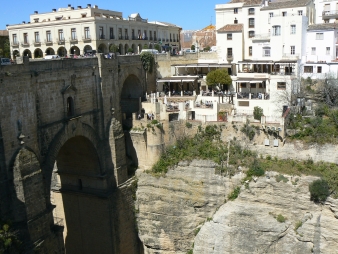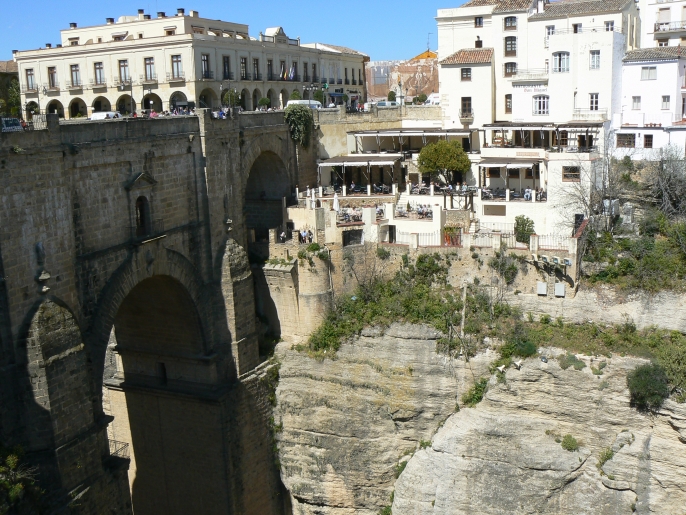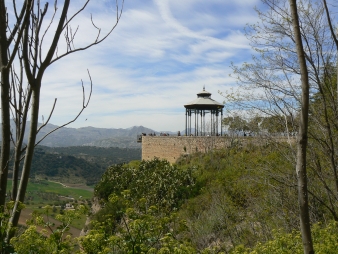Ronda Weather and Brief History
In neolithic times, man wandered across the fertile plains around present-day Ronda and evidence of his existence is found in the many caves that are scattered across this limestone plateau. The ‘Cueva de la Pileta’ , around 10 km from Ronda, discovered in 1905 by Jose Bullon Lombata, is one of the most important sites in Europe for primitive cave paintings. Shards of pottery and animal remains have been dated, and suggest that the complex of caves in the area were inhabited around 25,000 to 30,000 years BP. The necropolis ‘El Dolmen del Chopo’ is another example from this prehistoric age.Artefacts from the Bronze and Iron Ages, along with evidence of trade with the Phoenicians, have all emerged, much of it from archaelogical work carried out at the ancient city of Acinipo. This largely Roman town, about 15 km northwest of the modern Ronda, strategically sits on a limestone ridge that rises to just under 1000 metres. Habitation pre-dates the Roman era, but it is to the Romans that we owe most of the ruins that now remain. It was a thriving centre of trade 2000 years ago and, like many important Roman outposts of the day, it was allowed to mint coins. These coins have been discovered in many localities, but it appears that there was regular exchange of goods with the bustling port city of Cadiz.
As the Roman Empire collapsed during the 4 and 5th Centuries, so Acinipo slowly declined, eventually becoming affectionately known as Old Ronda. It remained occupied until at least the 14th Century, but with the Moors ruling this part of Spain, the favoured seat of government for the area became ‘New’ Ronda. Splendid buildings were erected, and after the Battle of Tarifa (1360) formidable defensive walls were built around the hill that Ronda is built on as a protection against the encroaching Catholics. Some of these walls, city gates, Moorish public baths and buildings are still in existence in the old quarter on the south side of Ronda.
Prior to the early 18th century, only one side of the gorge that bisects present-day Ronda, was urbanised. An old Roman bridge crossed the Guadalevin River 100 metres below the cliff face and a later 17th Century bridge made crossing the small river easier. However, in 1735 work started on spanning the top of the gorge and connecting the 2 limestone hills. After 8 months, the work to bridge the 35m wide canyon was complete, but unfortunately the design was not sound, and shortly after, the single arch collapsed into the river below, killing 50 people. Work on a magnificent new bridge was begun in 1751, and over 40 years later it was completed, and it still stands, imposing as ever, to this day.
In latter years, tourism has helped the economy of Ronda; and with a large selection of restaurants and hotels, as well as improved access to the the coast, the prospects for this well-positioned town look very rosy.
General Climate and Weather in Ronda
Enclosed by mountains, Ronda has a markedly different climate to that experienced along the Costa del Sol. The height above sea level, varying between 600 and 700 metres, helps to keep the summer heat tolerable, but in the winter it can be grey, cold and sometimes wet.
Weather in Ronda in January
| Average Maximum 13C/55F | Average Minimum 4C/39F | Days with rain falling 7 |
There will be plenty of sunshine during an average January, but it rarely feels warm. Frost is not uncommon on the clear nights, and the low humidity during the day often gives an ‘alpine’ feel to the air. On about 1 day in 4 statistically but, in batches of 3 or 4 days at a time in reality, the weather can be decidedly grim. Fog and low cloud cling to the drizzle swept hills and temperatures hover around 7 Celsius (45F), or less. Snow is not unknown, but cold rain is the more normal form of precipitation. Although the landscape may be green, this is not one of the better months to visit Ronda.
Weather in Ronda in February
| Average Maximum 15C/59F | Average Minimum 5C/41F | Days with rain falling 7 |
Most of this area lies above 500 metres so Spring is late arriving compared with on the coastal resorts. However, by the end of the month, wild flowers are in bloom and the buds of almond blossom should be opening. Much depends, of course, on the weather. Normally, the pattern of weather is similar to that of January. Fog or persistent low cloud can be a re-occurring problem in some years, especially if there has been a period of heavy rainfall. However, there should be many sunny days, but until the end of the month it still feels cold, and frost on the plain is a common sight at dawn.
Weather in Ronda in March
| Average Maximum 17C/63F | Average Minimum 5C/41F | Days with rain falling 6 |
Spring marches on relentlessly during this month, aided by the increasing warmth of the sunshine and the afternoon showers. Unfortunately for the farmers, the showers are not very reliable and in some years March can pass by with little in the way of useful rain. The low cloud and fog, regular features of the winter months, are much less prevalent during March with the fog usually dispersing 2 or 3 hours after dawn to leave pleasant sunshine. The evenings and nights are still too cold to linger for long outside the restaurants, but the afternoons are often warm enough to stroll through the gardens.
Weather in Ronda in April
| Average Maximum 19C/66F | Average Minimum 6C/43F | Days with rain falling 8 |
This month is arguably the best one in which to explore the area. The landscape still looks fresh. There are usually flowers in abundance and, for photography, the light and visibility can hardly be bettered. Although in most Aprils the sunshine predominates, showers can be expected with short-lived heavy, thundery downpours. There is normally sunshine between the showers and these showery episodes seldom last for more than 2 or 3 days at a time. Most days are pleasantly warm, and, especially towards the end of the month, temperatures can exceed 25 Celsius (77F).
Weather in Ronda in May
| Average Maximum 22C/72F | Average Minimum 10C/50F | Days with rain falling 5 |
The days are long and pleasantly warm, although on some occasions, especially during the second half of the month, it could be described as hot with temperatures approaching 30Celsius (86F). On these hot days the humidity is low and in the shade it feels much more comfortable than it does with similar, or even lower, temperatures on the coast. After sunset, temperatures fall quickly in the more rural areas, but it takes a while for this cool air to filter up the hill into the main part of Ronda. Occasional rainy days, or a mix of showers and sun occur, but with increasing rarity.
Weather in Ronda in June
| Average Maximum 27C/81F | Average Minimum 13C/55F | Days with rain falling 2 |
Apart from the odd thundery shower, or a short spell of rain from a rapidly weakening cold front as it crosses Spain from the Atlantic, the month of June is dry. Any fog is usually shallow and confined to the fields below Ronda in the period around dawn. As the month progresses it becomes increasingly hot and the landscape appears parched as the wild flowers wither in the heat. Temperatures of 35 Celsius (95F), or more, are not uncommon, especially towards the end of the month, but again the low humidity tempers the heat. The evenings usually remain pleasantly warm until after midnight.
Weather in Ronda in July
| Average Maximum 32C/90F | Average Minimum 15C/59F | Days with rain falling <1 |
The only element of the weather that usually changes during July is the temperature. Otherwise it is normally mostly sunny. Thin high cloud may spoil the sun occasionally and isolated fair-weather clouds develop during the heat of the afternoon before rapidly dissipating around dusk. The odd thunderstorm cannot be ruled out, and a dust-laden thundery shower may move north from Morocco overnight, but July is often a completely dry month. The humidity is generally low, so temperatures can fall quickly on the plains after dark. Up in Ronda, though, it normally stays much warmer.
Weather in Ronda in August
| Average Maximum 31C/88F | Average Minimum 15C/59F | Days with rain falling 1 |
Another hot month in Ronda and increasingly hazy. The blue haze is a combination of dust from the now brown landscape, and pollution. The pollution comes from grass and forest fires that break out across southern Europe at this time of year and from coastal traffic pollution that occasionally filters inland with a weak sea breeze during the summer months. The humidity usually becomes a little higher during August, especially if sea air is advected inland, but compared to the coast, the nights remain relatively cool. Towards the end of the month, there is an increasing risk of thunderstorms.
Weather in Ronda in September
| Average Maximum 28C/82F | Average Minimum 14C/57F | Days with rain falling 2 |
In some years September remains a summer month from beginning to end with high temperatures and little, if any, rainfall. In most years, though, the month will have at least one spell of thundery weather, which may last a couple of days, before sunshine returns under cleaner, bluer skies. It is not uncommon to find some of the highest temperatures of the ‘summer’ during early September, and the humidity may be high too, so early in the month the nights are often uncomfortably warm. Late in the month, tourist numbers fall, but it remains warm enough to leisurely explore the brown landscape.
Weather in Ronda in October
| Average Maximum 21C/70F | Average Minimum 11C/52F | Days with rain falling 6 |
This is the most fickle of months. In some years there is plenty of warm sunshine, ideal weather to explore the antiquities of the area. In other years it is cool and damp, especially late in the month when misty low cloud can linger all day after a night of fog. The mist and fog are usually at their worst after a spell of wet weather, and in October it can be particularly wet. Thundery rain can settle over the area for 2 or 3 days and, particularly towards the end of the month, it can be accompanied by a cold wind. However, by way of contrast, a week in Ronda in October may just be sunny and warm.
Weather in Ronda in November
| Average Maximum 16C/61F | Average Minimum 7C/45F | Days with rain falling 7 |
The weather descends into autumn, and sometimes winter, during November; and of all the months, the contrast between this part of southern Spain and the Mediterranean coast is starkest. There is little dilution of cold weather by the warm sea at Ronda, and the nights can be cold and frosty, especially across the plains. Fog and low cloud may persist for several days, but bright, warm days usually outnumber the poor days. Any traveller in November can expect rain, but a wet spell of weather seldom lasts for more than 3 or 4 days before the sunshine returns.
Weather in Ronda in December
| Average Maximum 13C/55F | Average Minimum 5C/41F | Days with rain falling 7 |
There are years when December in Ronda is sunny, and although not warm, it can be relatively pleasant. However, the weather may also be poor, and the bad conditions could last for several days. If the low ground is wet, then under clear skies fog will readily form. Sometimes, it remains on the plain while Ronda, high above, stays bathed in sunshine. Other times, though, the cold grey mist swirls round the buildings and temperatures fail to rise above 7 or 8 Celsius all day. On a few occasions, the surrounding mountains are cloaked in snow, but for Ronda that is a rare event.



